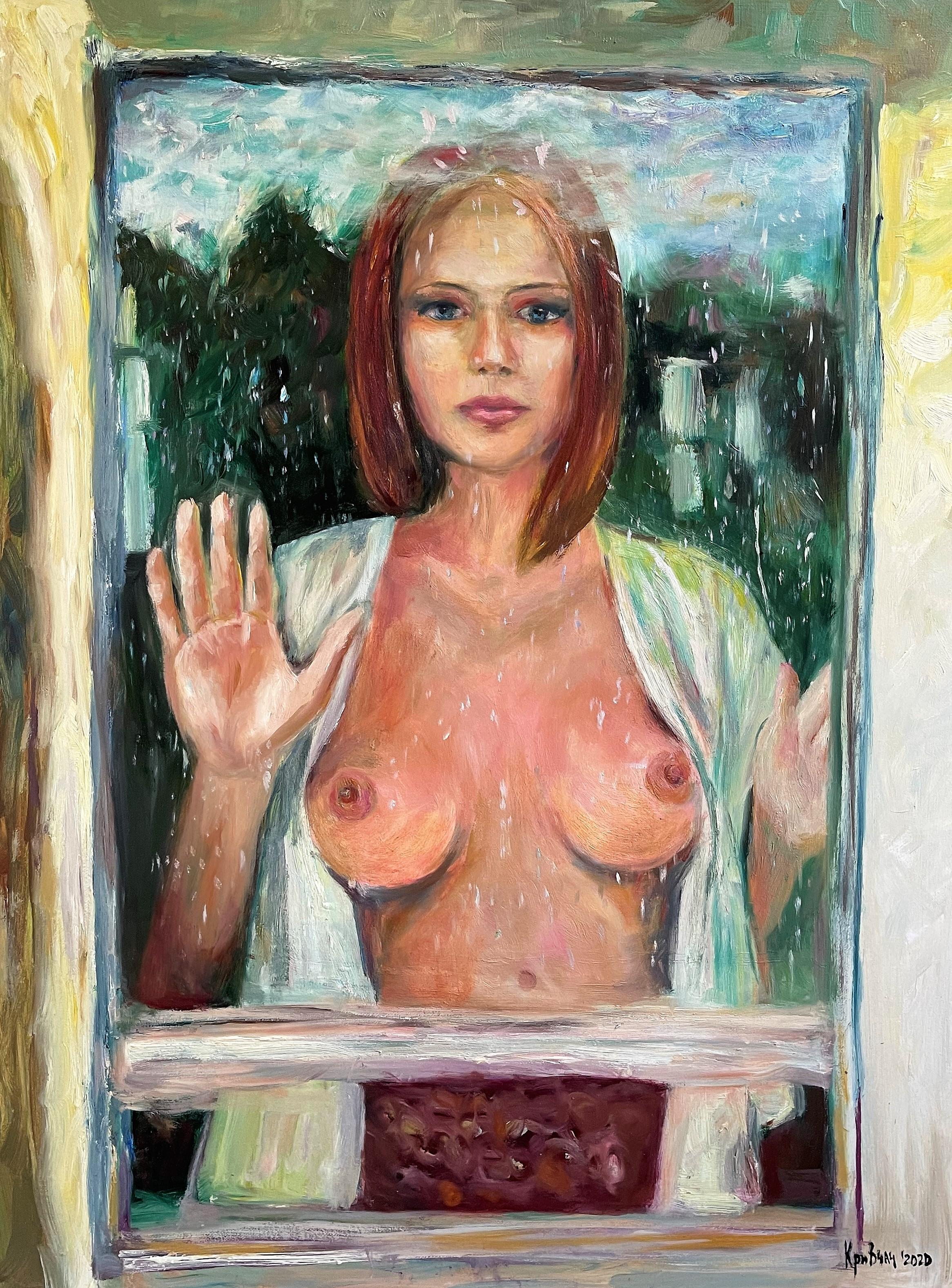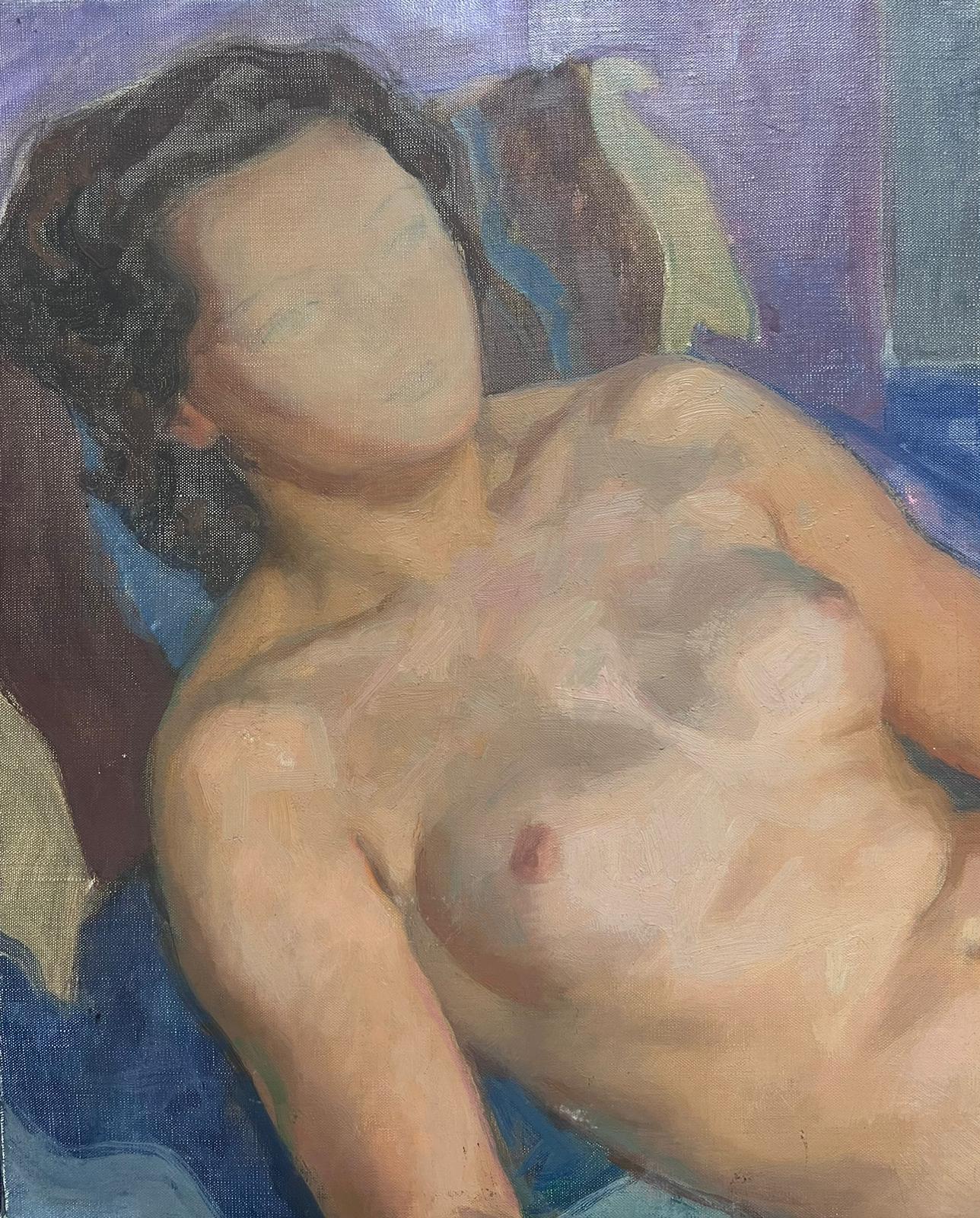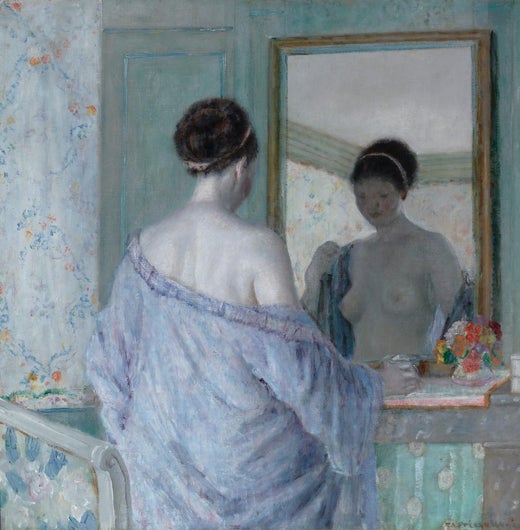Frederick Carl FriesekeAt the Mirrorcirca 1922
circa 1922
About the Item
- Creator:Frederick Carl Frieseke (1874-1939, American)
- Creation Year:circa 1922
- Dimensions:Height: 43 in (109.22 cm)Width: 42.5 in (107.95 cm)
- Medium:
- Movement & Style:
- Period:
- Condition:
- Gallery Location:New Orleans, LA
- Reference Number:
Frederick Carl Frieseke
Frederick Carl Frieseke studied at the Chicago School of Fine Arts from 1884, and at the Art Students League, New York. In 1888, he went to the Académie Julian in Paris, where he worked under Benjamin-Constant and Jean-Paul Laurens, also receiving advice from Whistler. In Paris, he also became acquainted with the work of contemporary artists, particularly Fantin-Latour and Renoir, and discovered Giverny, which he visited frequently during the summer months. In 1906, having achieved a degree of financial and artistic success, Frieseke was able to buy Théodore Robinson's former house in Giverny, which was next door to Monet's. In 1919, he moved to the Normandy village, Le Mesnil-sur-Blangy, where, after a brief return to the United States in 1937, he died.
Frieseke primarily painted female figures and nudes, such as Woman with a Mirror, Young Girl Playing the Piano or Model in Front of a Screen, gradually progressing to intimate scenes of women and, like Renoir, voluptuous nudes posed in the open air, their bodies lit by sunlight filtered through foliage. His methods ranged from a strictly Impressionist technique of separate brushstrokes, to one approaching divisionism, as in Mrs. Whitman's Garden of about 1912, to a broader application of color, as in Ladies in a Boat in Giverny of 1910. At times, he even went beyond Impressionism to a manner inspired by Fauvism, heightening the colors – mauves, blues and pinks – to “exaggerate the effect.” At the same time, Frieseke was also concerned, like Degas, with traditional figure painting, despite often setting them in an Impressionist-style landscape, as in Hollyhocks of 1912–13.
Frieseke took part in many group exhibitions in Paris, including the Salon des Artistes Français and the Société Nationale des Beaux-Arts, of which he became an associate member in 1901 and a permanent member in 1907. He held a solo show at the Venice Biennale in 1909, followed by another in Rome in 1911, and a show in New York in 1912. He received a number of distinctions: 1909, a gold medal at the Munich International Exhibition; 1913, the Temple Prize from the Pennsylvania Academy of the Fine Arts, Philadelphia; 1915, the Grand Prix at the Panama-Pacific International Exhibition, San Francisco; 1915, a gold medal at the Philadelphia Art Club; and was made a Chevalier de la Légion d'Honneur.
Find original Frederick Carl Frieseke paintings on 1stDibs.
(Biography provided by Leighton Fine Art Ltd.)
- ShippingRetrieving quote...Ships From: New Orleans, LA
- Return PolicyThis item cannot be returned.
- SolitudeBy Guillaume SeignacLocated in New Orleans, LAFrench Academic painter Guillaume Seignac was renowned for his masterful treatment of the idealized nude. His languishing female subjects based on Greco-Roman prototypes were and rem...Category
19th Century Academic Nude Paintings
MaterialsCanvas, Oil
- SolitudeBy Guillaume SeignacLocated in New Orleans, LASigned “G-Seignac” (lower right) Oil on canvas French Academic painter Guillaume Seignac was renowned for his masterful treatment of the idealized nude. His languishing female subje...Category
19th Century Academic Nude Paintings
MaterialsCanvas, Oil
- SalomeLocated in New Orleans, LAThis compelling portrait of Salome was composed by the French painter Marie Felix Hippolyte-Lucas. While the celebrated artist's oeuvre is filled with bright and cheerful portraits of aristocratic women surrounded by florals, here he takes a different approach. Hippolyte-Lucas' Salome is simultaneously exotic and highly modern, rendered in a style that is both theatrical and bold. The monumental work's rich color palette is filled with gem-inspired hues that lend drama to the scene, highlighting the blatant sexuality of this legendary seductress. Though Salome is not named in the New Testament, she has appeared time and time again in art and literature over the centuries, as both an innocent and a seductress. Her mother, Herodias, resented John the Baptist, who denounced her marriage to King Herod as unlawful. At one evening meal, Salome danced...Category
19th Century Other Art Style Nude Paintings
MaterialsCanvas, Oil
- The Bather by Childe HassamBy Childe HassamLocated in New Orleans, LAChilde Hassam 1859-1935 American The Bather Signed and dated “Childe Hassam” (lower right) Oil on canvas Considered by many to be America’s foremost Impressionist painter, Childe Hassam composed his tranquil and intimate oil on canvas The Bather in the early years of the 20th century. The creation of the artwork aligns with a period of Hassam’s career where the artist’s palette was transforming, matching ever closer with the pale and pastel hues of French Impressionists like Claude Monet. Even the subject — a nude woman — represents a greater alignment with the Impressionist project, as artists of the movement and their non-mythological and non-biblical nudes still generated cries of indecency. With Hassam’s signature brushwork and attention to color, The Bather serves as a dream-like vision, serene and sensuous, of a young woman bathing in a lush forest. While the artist's skill for landscape painting is on display, it is Hassam's command of form, light and color that brings this canvas to life. He creates a captivating composition, placing the nude subject in the bottom left of the canvas. The soft, undulating curves of the woman's body in contrapposto and the glow of her fair skin are balanced by the strong verticals and deep earth tones of the tall trees to her right. Hassam delicately frames the nude in the vivid blues of the distant water, building luminous color that further draws the viewer’s eye and results in a somewhat voyeuristic appeal — endowing his nude with both a natural innocence and an intentional sensuality. Born in Dorchester, Massachusetts, Childe Hassam began his artistic career as a freelance illustrator, working for national publications such as Harper’s Weekly, Scribner’s Monthly, and The Century. His first solo exhibition of watercolors took place in Boston in 1883, and he quickly catapulted onto the international scene, winning a bronze medal at the Exposition Universelle in Paris in 1889. The year before the present work was created, he received the Webb Prize from the Society of American Artists for another landscape painted at Gloucester. Hassam would receive numerous other awards throughout his career, most notably the Gold Medal for Distinguished Services to Fine Art from the American Dealers Association. A true master, Hassam depicted a way of life characteristic of both American and French society, and his work elucidates a critical chapter in American art history. Today, his work resides in the Oval Office of the White House and in numerous important museums, including the Metropolitan Museum of Art in New York, the National Gallery of Art in Washington, DC and the Museum of Fine Arts in Boston, among others. This painting will be included in Stuart P. Feld's and Kathleen M. Burnside's forthcoming catalogue raisonné of the artist's work. Circa 1905 Canvas: 24 1/2“ high x 20 18” wide Frame: 35 7/8“ high x 31 1/4” wide x 3 1/4“ deep Provenance: Private Collection of William Young...Category
20th Century Impressionist Nude Paintings
MaterialsCanvas, Oil
- Après le bain (After the bath)By Pierre Auguste RenoirLocated in New Orleans, LAFor Pierre-Auguste Renoir, Impressionism's pre-eminent figure painter, depicting the nude was an exercise in bringing the canvas to life. He once said, “I look at a nude, I see myriads of minuscule shades. I have to find those which will make the flesh on my canvas come to life and resonate.” This compelling portrait by Renoir entitled Après le bain presents the nude figure of a woman in a serene, private moment, absorbed in the task of drying herself after a bath. The artist’s mastery of light and shading is incredible, achieving a sense of vitality in this otherwise ordinary scene. Renoir is celebrated for his figural work, especially his Rubenesque female nudes, however, it was not until the artist was in his forties that he depicted the nude with any frequency. In 1881, Renoir traveled to Italy, where he studied the works of the Renaissance masters and the ancient art of Pompeii and Rome. Upon his return to France, the nude became his favored subject, and he used the motif to combine the spontaneity of Impressionism with the solid modeling of classical painting. Renoir’s medium here, sanguine, a reddish-brown chalk, was used extensively in the Renaissance by Leonardo (who employed it in his sketches for the Last Supper), Michelangelo and Raphael. Its warm hue lends itself well to depicting flesh, and the chalk drawing allows for a greater focus on line, form and texture in a departure from the aspects of color and light that so often preoccupied the Impressionists. Après le bain conveys the impression of arrested motion with perfect naturalness, deftly capturing the moment before the elegant lines of the sitter's form change position. The sitter is almost certainly Gabrielle Renard, the nanny to Renoir’s children and a frequent model for the artist. Gabrielle was the cousin of Renoir’s wife, Aline, and came to Montmartre to work for the family at the age of 16. She developed a strong bond with the family and became a favorite subject for Renoir, appearing in several of his most important works, including his 1911 Gabrielle with a Rose (Musée d'Orsay). When Renoir began to suffer from severe rheumatoid arthritis that would eventually leave him unable to walk and scarcely able to grasp a paintbrush, it was Gabrielle that would assist the artist by positioning the paintbrush between his crippled fingers. Born in Limoges, France in 1841, Renoir began his career as an apprentice to a painter of porcelain wares. He later moved to Paris at the age of 21, enrolling at the prestigious École des Beaux-Arts. It was here, while studying under Charles Gleyre, that Renoir attained a tremendous appreciation for the academic style of painting, a quality that would last throughout his career. This was also when he met Claude Monet and several other classmates, with whom he would later form the Impressionists. Working closely with Monet, Renoir began experimenting with the portrayal of light and its effect on his canvases. The youngest member of the Impressionist movement, an astute Renoir recognized how a subject was constantly changing due to the dynamic effects of light on color. Relying heavily upon his academic training that focused on composition, lines and descriptive details, Renoir distinguished himself among his contemporaries. His intuitive use of color and expansive brushstroke, along with acute attention to his subject, have placed him among the finest painters in history. This work is accompanied by a certificate of authenticity and will be included in the forthcoming catalogue raisonné of the work of Pierre-Auguste Renoir from the Wildenstein Plattner Institute. Circa 1898 Canvas: 43 1/2" high x 35 1/2" wide Frame: 57 3/4" high x 49 1/4" wide Provenance: Galerie Durand-Ruel, Paris (acquired from the artist on January 25, 1899) J. Pereire Collection, France (1966) Sam Salz, New York (before 1981) Claus Virch, Paris French Compagny, Inc., New York Larry Silverstein, New York (circa January 1987) Le Clos de Sierne Gallery, Geneva Galerie Heyram, Paris (October 1987) Francis Gross M.S. Rau, New Orleans Literature: B. Schneider, Renoir, Berlin, 1957, p. 95 (illustrated in color, p. 83) M. Gauthier, Renoir, Paris, 1958, p. 83 (illustrated in color; erroneously dated '1916' and titled 'Woman in her toilet') F. Fosca, Renoir, L'homme et son obra, Paris, 1961, p. 280 (illustrated, p. 95; erroneously dated 'about 1890' and titled 'After the Bath...Category
19th Century Impressionist Nude Paintings
MaterialsCanvas, Paper, Chalk
- Italian Panel with Satyr and NymphsLocated in New Orleans, LAThis extraordinary Italian gouache and oil on canvas brings two of the most popular characters from Greek mythology vividly the life - the nymph and the satyr. Both creatures are famed for their carefree natures and lascivious temperaments, and tales abound of satyrs pursing nubile nymphs in order to rape or seduce them, usually with little success. One such narrative humorously unfolds in the present piece, which depicts an indignant satyr captured by three nymphs with a golden net. The relationship between these two mythological creatures was a popular one for artists throughout the 18th and 19th centuries, though its origins stretch back to antiquity. Both satyrs and nymphs...Category
Early 19th Century Other Art Style Figurative Paintings
MaterialsCanvas, Oil, Gouache
- Vintage American School Boudoir Scene Nude Female Interior Portrait PaintingLocated in Buffalo, NYAntique impressionist painting. Watercolor and gouache on paper, circa 1950. Housed in a vintage frame. Image size, 11L x 9H.Category
1950s Impressionist Portrait Paintings
MaterialsCanvas, Oil
- Girl at the windowLocated in Aberdeen Dyce, GB“Real beauty is not one that one admires with pleasure, but one that is as difficult to look at as the sun.”Category
2010s Impressionist Nude Paintings
MaterialsCanvas, Oil
- Girl jugglerLocated in Aberdeen Dyce, GBThis painting shows a girl with a juggling ball in her hand. Her image includes both coldness and vulnerability. Thanks to her ball, she juggles her life.Category
2010s Impressionist Nude Paintings
MaterialsCanvas, Oil
- French School - PS 233 La Fauve s'habille en Leopard Oil Post ImpressionistLocated in Sempach, LUPs 233 La Fauve S'habille en leopard. (Tawny wears leopard) Portrait of a naked woman who is carrying a leopard. Structural analysis: Closeup portrait of a naked woman. The backgro...Category
2010s Impressionist Portrait Paintings
MaterialsCanvas, Ink, Oil, Acrylic
- 1950's French Modernist Oil Painting Portrait Sketch of Nude LadyBy Maurice DelavierLocated in Cirencester, GloucestershireThe Nude Model by Maurice Delavier (French 1902-1986) stamped verso oil painting on canvas, 16 x 13 inches condition: overall good and original provenance: from a collection of this ...Category
Mid-20th Century Impressionist Portrait Paintings
MaterialsOil, Canvas
- "(Waiting for) the Onset of Colors, " Oil paintingBy Hollis DunlapLocated in Denver, COHollis Dunlap's (US based) "(Waiting for) the Onset of Colors" is an original, handmade oil painting that depicts a woman in profile with long dark hair ...Category
2010s American Impressionist Nude Paintings
MaterialsLinen, Oil
Recently Viewed
View AllRead More
Wear Louis Comfort Tiffany’s Genius on Your Finger with This Vivid Ring
In his jewelry making, the designer rarely used diamonds — this rare example has two.
You Won’t Find a More Handsome Stopwatch Than This 1890s Pocket Chronograph
A Grand Complication from the golden era of pocket watches, the Marius Lecoultre pocket watch does everything but uncork your wine.




